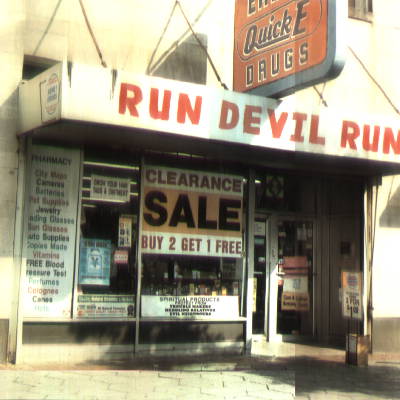 |
From the Vault...
01/07/2018
#1602 |

|
info
Paul McCartney
"Run Devil Run"
© Capitol Records
Year of Release: 1999
Rating:


|
track listing
Blue Jean Bop
She Said Yeah
All Shook Up
Run Devil Run
No Other Baby
Lonesome Town
Try Not To Cry
Movie Magg
Brown Eyed
Handsome Man
What It Is
Coquette
I Got Stung
Honey Hush
Shake A Hand
Party
|
WSVNRadio Archives
Paul McCartney related sites:
|
|
|
Paul McCartney
"Run Devil Run"
One of his later releases, Paul McCartney's Run Devil Run is from 1999. It's an album of 1950s familiar and not-so-familiar tracks. Plus
there are three original songs, written by McCartney in the 1950s style. McCartney's best music has been behind him by now, preferably with his band
Wings. But, Run Devil Run has some very impressive tracks that put him back in the Rock & Roll highlights. Although none of the songs here
acclaimed popular status as his Beatles/Wings/solo tunes in his heyday. At age 57 in 1999, McCartney's wife Linda had passed away the year before.
From that time until this album's release, he was in mourning. Yet when he did return to record a new album, he still knows how to rock it out.
The album opens with a Gene Vincent song, "Blue Jean Bop." One of many of this album's highlights, it's a true rockabilly track, and a great
song to start out the album. Then there's the absolute solid rocker, "She Said Yeah," which was recorded by Larry Williams. Sir Paul does it
again, by knowing how to Rock! Elvis Presley's "All Shook Up" is even more rocking that the King's original version. Likewise, the title track
(a McCartney original), is in another solid rock form, as this song was written in the Chuck Berry style.
And, like most albums, there are the songs that slows down the pace a bit, as the first three songs simply rocks it out. "No Other Way" is
an obscure song that most probably never heard of. But it was recorded by the skiffle group, The Vipers. Although it's more of a laid back style,
McCartney does a very good job on it. Ricky Nelson's "Lonesome Train" is another laid back, and more of this than the previous track.
"Try Not To Cry" is the second of three McCartney originals, as he gives this track an updated feel, yet in the 1950s style. (The song was
recounting a widower's sadness, as Linda McCartney had passed away in 1998, of breast cancer. She was 56 years old.)
Country Sir Paul? "Movie Magg" was recorded by Carl Perkins, as Paul records his version, sounding like the early country, as in Johnny Cash --
(his "train sounding" style, as in "Folsom Prison Blues," or even sounding like John Fogerty's solo material. Speaking of Fogerty, Chuck Berry's
"Brown Eyed Handsome Man" has the style of a Fogerty song as well. The third McCartney original, "What It Is" was written a few months
prior to Linda's death. This track is not as appealing as the others, yet it's Paul, and possibly his preparation in saying goodbye to his wife.
"Coquette" is different, as is more of a talking song, as this track was recorded by Fats Domino. The album returns to more songs that gets
Paul back in the Rock & Roll mood. Elvis Presley's "I Got Stung" and Johnny Burnette's "Honey Hush" are both solid rockers. And a nice
1950s feel gets Little Richard's "Shake A Hand." The album closes with an obscure song that was recorded by Elvis, "Party." Yet this
tracks sounds more like it would be recorded by Little Richard. Most notably, his classic "Long Tall Sally."
McCartney does extremely well with his 1950s look at Run Devil Run. A great assortment of well-known, obscure and originals by Sir Paul.
This album may not rank highly as his most popular solo albums, but he still knows how to record great music. He is now 75 years old, and he is still
recording. Not only has he recorded great Rock & Roll, he has added Big Band (Kisses On The Bottom, 2012), and as of 2011, five Classical albums.
Sir Paul McCartney has always proved that he can still write and record great music, whatever style it would be.
© WSVNRadio.net. All rights reserved.
Review or any portion may not be reproduced
without written permission. Cover art is the
intellectual property of
Capitol Records
and is used for reference purposes only.
|
|




